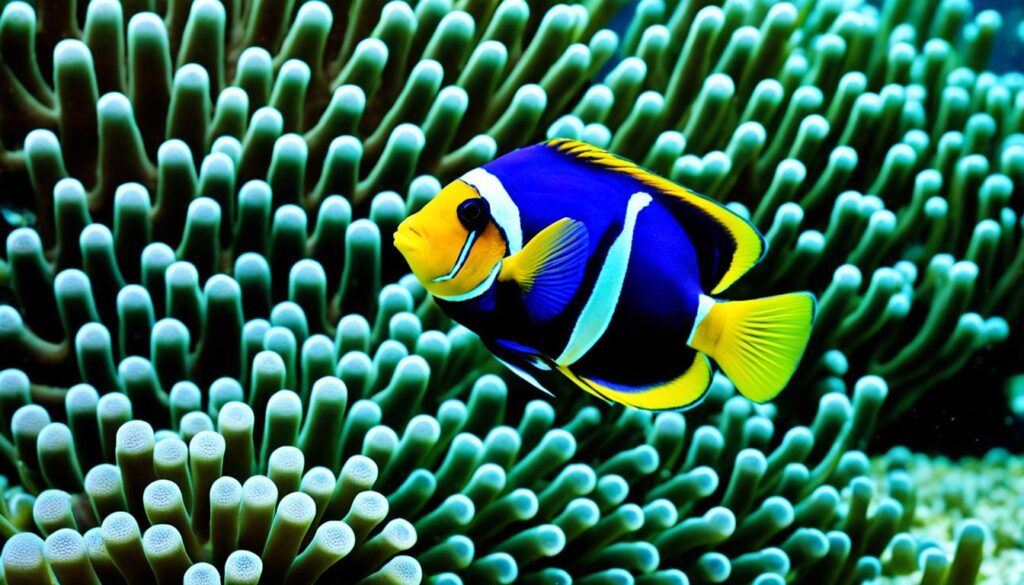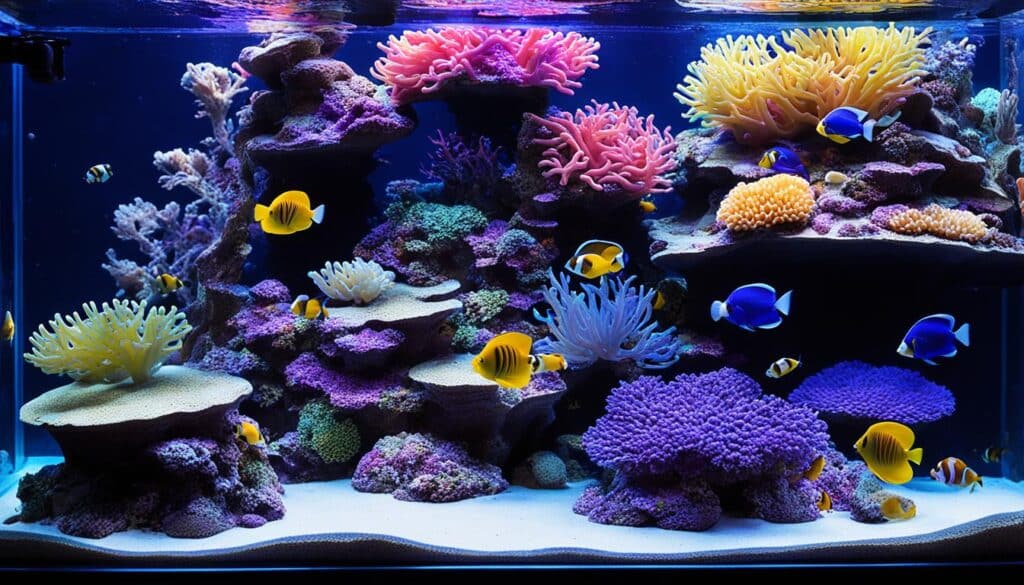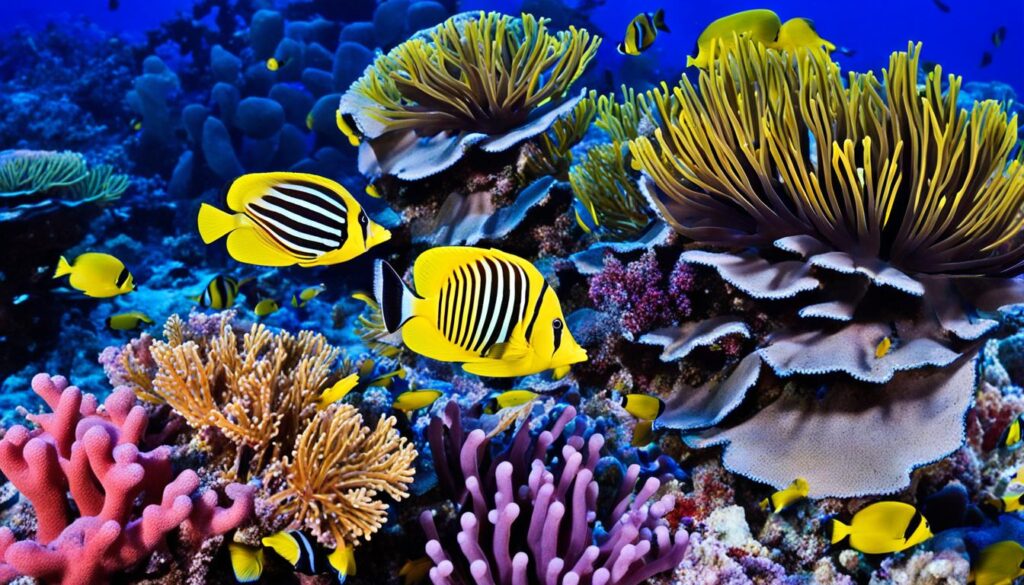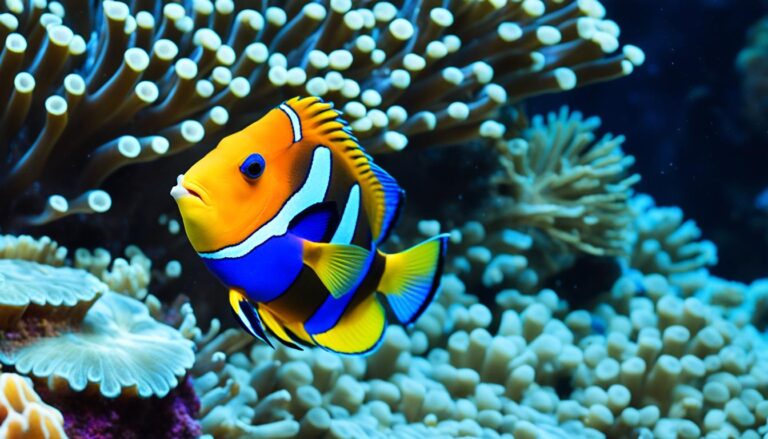The first time I saw a Clown Tang, its beauty was obvious. Its bright stripes look like a clown’s costume. They catch your eye in any saltwater aquarium. These fish come from the diverse Indo-Pacific waters. They are wild-caught and need careful attention because of their complex needs.
As someone who loves saltwater aquariums, I know why people want a Clown Tang. They are stunning to look at. But they get big, about 12 to 14 inches as adults. So, they need a lot of room to swim. A tank of at least 250 gallons is necessary for them.
Clown Tangs live a long time in the wild, up to 30 years. But in a tank, they usually live about 10 years. To help them live longer, keep their water’s temperature between 75 and 82°F. The pH should be 8.1 to 8.4. And the water’s specific gravity should be 1.020 to 1.025.
Clown Tangs eat mainly plants. So, they need lots of live rock to graze on in their tank. You can also give them some shrimp and krill. Because they are sensitive, it’s essential to have strong filters. This keeps their water clean and clear.
Clown Tang Species Profile

The Acanthurus lineatus, or Clown Tang, shines brightly in reef tanks. It’s from warm waters in places like Fiji and the Maldives. This fish is known for its cool blue and yellow stripes and unique tail. It’s a big member of the Surgeonfish family. To keep one happy, you need to know about their space, food, and the right tank conditions.
Clown Tangs love a well-set-up reef tank that feels like home. They enjoy tanks with lots of live rock. These rocks give them places to graze and hide. You can feed them flake food, spirulina, dried seaweed, and sometimes brine shrimp. This keeps them healthy and their colors bright.
Here’s what you need to know for a happy Clown Tang:
Characteristic |
Requirement |
|---|---|
Minimum Tank Size |
240 gallons |
Tank Length |
At least 6 feet |
Water Surface Area |
Approximately 706 square inches |
Temperature Range |
75°F – 83°F (24°C – 28°C) |
pH Range |
8.0 – 8.4 |
Specific Gravity |
1.020 – 1.025 |
It’s important to get these conditions right for a Clown Tang. With the right care, this stunning fish can thrive in your reef aquarium. It adds beauty and life to your underwater world.
Size and Growth of Clown Tangs

Clown Tangs stand out due to their size and growth. Known for their bright colors, they thrive in elaborate marine setups. They grow quickly and can reach impressive sizes.
The Impressive Size of Adult Clown Tangs
Adult Clown Tangs, a key part of the Surgeonfish family, grow up to 14 to 17 inches long. Their large size and bold colors make them the highlight of any reef tank.
Growth Rate Compared to Other Marine Species
The growth of Clown Tangs is quite remarkable when compared to others in the sea. They need big tanks to fit their size as they get older.
See the table below for a comparison of Clown Tangs with other marine creatures. It covers size, tank needs, and diet, helping fish keepers care for these colorful fish.
Characteristic |
Clown Tang |
Other Tropical Fish |
|---|---|---|
Max Size |
Up to 17 inches |
Varies (typically smaller) |
Min Tank Size |
250 gallons |
Varies (often less than 250 gallons) |
Diet |
Herbivores, relying heavily on marine algae |
Omnivores/herbivores/carnivores (based on species) |
Reef Compatibility |
Reef-safe but can nip at coral polyps |
Highly variable |
Lifespan in Captivity |
5 to 7 years |
Varies widely |
Knowing how Clown Tangs grow compared to other fish is key for aquarists. With enough space and the right food, these fish will show off their beauty and energy in your tank.
Lifespan of a Clown Tang

Knowing how long clown tangs live in an aquarium is key to taking good care of them. They don’t live as long in tanks as they do in the ocean, where they can reach 42 years. The main reason is it’s hard to match their natural habitat in an aquarium.
From my experience with marine tanks, setting up the tank like their natural home is crucial. This includes things like water quality and keeping stress low. Their diet is also very important.
Let’s compare how long different tangs can live when we take really good care of them:
Species |
Lifespan in Captivity |
Lifespan in the Wild |
|---|---|---|
Purple Tangs |
Over 20 years |
N/A |
Yellow Tangs |
Approaching 15 years |
N/A |
Blue Tangs |
20 years |
N/A |
Zoster Butterflies |
15 years |
N/A |
Clown Tangs |
Up to 10 years |
Up to 42 years |
Remember, the lifespan of clown tangs can change depending on the care they get. Checking the tank often and keeping it in top shape is important. Taking care of these beautiful fish has shown me that a bit more effort can really improve their life and health in tanks.
Essential Diet Tips to Maintain a Healthy Clown Tang

To keep Clown Tangs healthy in your marine aquarium, it’s key to know their diet. They need a variety of foods, like in the wild. This helps your marine ecosystem stay vibrant.
The Herbivorous Nature of Clown Tangs
Clown Tangs feed on marine algae in the ocean. In tanks, it’s vital to give them similar food to prevent health problems. Marine algae sheets work well. You can clip these to the tank for all-day grazing.
Supplemental Foods for Optimal Health
Clown Tangs also need protein foods now and then. Foods like brine shrimp and krill add to their diet. But, these are just extras, not the main part of their diet.
A balanced diet is important for Clown Tangs. Here’s a list of good foods for them, how often to feed, and the benefits:
Food Type |
Frequency |
Benefits |
|---|---|---|
Marine Algae Sheets |
Daily |
Meets basic dietary needs, mimics natural grazing behavior |
Brine Shrimp |
Twice a week |
Provides protein, enhances color vibrancy |
Mysis Shrimp |
Twice a week |
Additional protein source, good for growth |
Chopped Krill |
Once a week |
High protein, aids in muscle development |
Nori |
Three times a week |
Rich in vitamins, improves immune system |
Following these feeding tips, with lots of marine algae and some protein, will help your Clown Tang flourish.
How to Set Up the Perfect Tank for Your Clown Tang

Setting up the right marine aquarium for a clown tang is vital. It ensures the fish stays healthy and happy. The perfect tank setup lets your marine buddy show off its bright colors and lively ways. Let’s look at what makes a great home for clown tangs.
Selecting the Right Tank Size and Shape
The tank’s size and shape are key for a clown tang’s happiness. They need room to swim freely. Experts agree on what size tank works best for these fish:
Source |
Minimum Tank Size |
Recommended Tank Size |
|---|---|---|
Liveaquaria.com |
150 gallons |
250 gallons |
Saltwaterfish.com |
90 gallons |
200 gallons |
Bluezooaquatics.com |
100 gallons |
200 gallons |
Vividaquariums.com |
100 gallons |
250 gallons |
Reefhotspot.com |
125 gallons |
250 gallons |
Forum Member rachenbrazil |
200 gallons |
500 gallons |
Forum Moderator Wolverine |
500 gallons |
1000 gallons |
Many suggest a large tank, between 250 to 500 gallons, for a clown tang. A long, rectangular tank is best. It gives them the space they need to swim and stay healthy.
Creating Strong Currents: Equipment and Placement
Clown tangs love strong currents, just like in the ocean. To do this in a tank, you need powerful water movers, like powerheads. This helps make the water clean and full of oxygen. Both are crucial for the fish’s health:
- Positioning multiple powerheads around the tank makes the currents even and avoids bad spots.
- Aiming the powerheads at open spaces simulates ocean waves. This keeps the clown tang active and healthy.
- Regular maintenance of these devices keeps them working well. This makes a great environment for your clown tang.
Adding these elements to your tank makes a wonderful home for a clown tang. With good planning and the right equipment, your tank can be a lively marine world. It gives your clown tang a happy and beautiful place to live.
Choosing Compatible Tank Mates for a Clown Tang

Adding a Clown Tang to your marine aquarium requires knowing their needs and behaviors. These fish are part of the Surgeonfish family. It’s important to choose their tank mates carefully to avoid conflicts.
Identifying Aggressive Tendencies in Clown Tangs
Clown Tangs become more territorial as they grow, especially once they are about 6 inches long. They are lively and do well in big reef tanks. But, they may try to dominate. You should watch how they interact with other fish, especially new ones.
Community Tanks: Peaceful Companion Ideas
For a community tank with a Clown Tang, pick compatible tank mates. Good choices are fish that won’t make the Clown Tang feel threatened or crowd its space. Fish that are peaceful and like reef tank settings can live with Clown Tangs. They just need to be introduced carefully and have enough room.
Here is a table of species that get along well with Clown Tangs. It looks at their needs and how they behave:
Species |
Size (Average) |
Environment Compatibility |
Aggression Level |
|---|---|---|---|
Clown Fish |
3\” – 4\” |
Compatible with live rock and reef setting |
Low |
Cleaner Wrasse |
4\” – 6\” |
Requires hiding spots; reef safe |
Very Low |
Small Purple Tangs |
Up to 7\” |
Fits well in larger tanks (200+ gallons) |
Moderate |
Choosing fish to live together in a reef tank needs careful thought. You must consider both how they act and their needs. By planning well, you can make a marine habitat that is both lively and peaceful.
The Clown Tang: A Hobbyist Favorite with Vibrant Colors
The Clown Tang is a favorite in the world of saltwater fish because of its stunning colors and lively personality. These fish move through the water with glistening colors that catch everyone’s eye. Though beautiful, they are a challenge for aquarium lovers. They can live up to 14 years with the right care. Many people, including myself, find joy in taking care of Clown Tangs. It’s both a rewarding hobby and a science.
Clown Tangs grow quickly, reaching up to 40 cm. Their growth in the first year shows their full-of-life character. But, they can be aggressive towards other fish in the tank. Starting them in the tank at a small size and feeding them special 1mm pellets can help avoid fights. In my tank, with lots of water flow and open space, my Clown Tang does very well. Its colors are always a joy to see.
Their diet is crucial for their health, with NLS pellets often recommended. They can live with other tangs if monitored during feeding to prevent fights. Even with necessary precautions, like having a big enough tank, Clown Tangs are still loved. They look amazing, whether alone or with other fish like Purple Tangs. Caring for them has given me a sense of having underwater adventures at home. My bond with my Clown Tang shows in its every sparkle.








